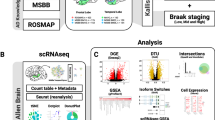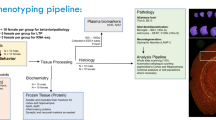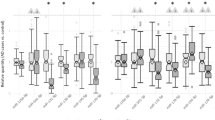Abstract
Alzheimer’s disease (AD) is a uniquely human, age-related central nervous system (CNS) disorder for which there is no adequate experimental model. While well over 100 transgenic murine models of AD (TgAD) have been developed that recapitulate many of the neuropathological features of AD, key pathological features of AD such as progressive neuronal atrophy, neuron cell loss, and neurofibrillary tangle (NFT) formation have not been observed in any TgAD model to date. To more completely analyze and understand the neuropathology, altered neuro-inflammatory and innate-immune signaling pathways, and the complex molecular-genetics and epigenetics of AD, it is therefore necessary to rigorously examine short post-mortem interval (PMI) human brain tissues to gain a deeper and more thorough insight into the neuropathological mechanisms that characterize the AD process. This perspective-methods paper will highlight some important recent findings on the utilization of short PMI tissues in sporadic (idiopathic; of unknown origin) AD research with focus on the extraction and quantification of RNA, and in particular microRNA (miRNA) and messenger RNA (mRNA) and analytical strategies, drawing on the authors’ combined 125 years of laboratory experience into this investigative research area. We sincerely hope that new investigators in the field of “gene expression analysis in neurological disease” will benefit from the observations presented here and incorporate these recent findings and observations into their future experimental planning and design.

Similar content being viewed by others
Abbreviations
- AD:
-
Alzheimer’s disease
- ALU:
-
Alu human genomic repeated sequence (~300 base pair)
- CNS:
-
Central nervous system
- EEG:
-
Electroencephalogram
- mRNA:
-
Messenger RNA
- miRNA:
-
Micro RNA
- PMI:
-
Post-mortem interval
- TgAD:
-
Transgenic animal model of AD
- TREM2:
-
Triggering receptor expressed in myeloid/microglial cells
References
Duff K (2002) Neuropsychopharmacology: the fifth generation of progress. Lippincott, Williams, & Wilkins, Philadelphia, Pennsylvania; edited by KL Davis, D Charney, JT Coyle, and C Nemeroff. Am Coll Neuropsychol-Pharmacol
Webster SJ, Bachstetter AD, Nelson PT, Schmitt FA, Van Eldik LJ (2014) Using mice to model Alzheimer’s dementia: an overview of the clinical disease and the preclinical behavioral changes in 10 mouse models. Front Genet 5:88. doi:10.3389/fgene.2014.00088
Foley AM, Ammar ZM, Lee RH, Mitchell CS (2014) Systematic review of the relationship between amyloid-β levels and measures of transgenic mouse cognitive deficit in Alzheimer’s disease. J Alzheimers Dis 2014 Oct 31. [Epub ahead of print] PubMed PMID: 25362040.
Franco R, Cedazo-Minguez A (2014) Successful therapies for Alzheimer’s disease: why so many in animal models and none in humans? Front Pharmacol 5:146. doi:10.3389/fphar.2014.00146
Watts JC, Prusiner SB (2014) Mouse models for studying the formation and propagation of prions. J Biol Chem 289:19841–19849. doi:10.1074/jbc.R114.550707
Pluta R, Jabłoński M, Ułamek-Kozioł M, Kocki J, Brzozowska J, Januszewski S, Furmaga-Jabłońska W, Bogucka-Kocka A, Maciejewski R, Czuczwar SJ (2013) Sporadic Alzheimer’s disease begins as episodes of brain ischemia and ischemically dysregulated Alzheimer’s disease genes. Mol Neurobiol 48:500–515. doi:10.1007/s12035-013-8439-1
Pluta R, Furmaga-Jabłońska W, Maciejewski R, Ułamek-Kozioł M, Jabłoński M (2013) Brain ischemia activates β- and γ-secretase cleavage of amyloid precursor protein: significance in sporadic Alzheimer’s disease. Mol Neurobiol 47:425–434. doi:10.1007/s12035-012-8360-z
Hossain MS, Gilbert P (2010) Concepts of death: a key to our adjustment. Illness, Crisis and Loss, Vol 18. No 1
Preece P, Cairns NJ (2003) Quantifying mRNA in postmortem human brain: influence of gender, age at death, postmortem interval, brain pH, agonal state and inter-lobe mRNA variance. Brain Res Mol Brain Res 118:60–71
Hyman BT, Phelps CH, Beach TG, Bigio EH, Cairns NJ, Carrillo MC et al (2012) National Institute on Aging-Alzheimer’s Association guidelines for the neuropathologic assessment of Alzheimer’s disease. Alzheimers Dement 8:1–13. doi:10.1016/j.jalz.2011.10.007
Lukiw WJ, LeBlanc HJ, Carver LA, McLachlan DR, Bazan NG (1998) Run-on gene transcription in human neocortical nuclei. Inhibition by nanomolar aluminum and implications for neurodegenerative disease. J Mol Neurosci 11:67–78
Cui JG, Zhao Y, Lukiw WJ (2005) Isolation of high spectral quality RNA using run-on gene transcription; application to gene expression profiling of human brain. Cell Mol Neurobiol 25:789–794
Bhattacharjee S, Lukiw WJ (2013) Alzheimer’s disease and the microbiome. Front Cell Neurosci 7:153. doi:10.3389/fncel.2013.00153
Hill JM, Clement C, Pogue AI, Bhattacharjee S, Zhao Y, Lukiw WJ (2014) Pathogenic microbes, the microbiome, and Alzheimer’s disease (AD). Front Aging Neurosci 6:127. doi:10.3389/fnagi.2014.00127
Can I, Javan GT, Pozhitkov AE, Noble PA (2014) Distinctive thanatomicrobiome signatures found in the blood and internal organs of humans. J Microbiol Methods 106:1–7. doi:10.1016/j.mimet.2014.07.026
Lukiw WJ, Alexandrov PN (2012) Regulation of complement factor H (CFH) by multiple miRNAs in Alzheimer’s disease (AD) brain. Mol Neurobiol 46:11–19
Rajagopalan LE, Malter JS (1997) Regulation of eukaryotic messenger RNA turnover. Prog Nucleic Acid Res Mol Biol 56:257–286
Sethi P, Lukiw WJ (2009) Micro-RNA abundance and stability in human brain: specific alterations in Alzheimer’s disease temporal lobe neocortex. Neurosci Lett 459:100–104. doi:10.1016/j.neulet.2009.04.052
Pogue AI, Hill JM, Lukiw WJ (2014) MicroRNA (miRNA): sequence and stability, viroid-like properties, and disease association in the CNS. Brain Res 1584:73–79. doi:10.1016/j.brainres.2014.03.042
Donaldson AE, Lamont IL (2013) Biochemistry changes that occur after death: potential markers for determining post-mortem interval. PLoS One 8(11):e82011. doi:10.1371/journal.pone.0082011
Lukiw WJ (2013) Variability in microRNA (miRNA) abundance, speciation and complexity amongst different human populations and potential relevance to Alzheimer’s disease (AD). Front Cell Neurosci 7:133. doi:10.3389/fncel.2013.00133
Lukiw WJ, Handley P, Wong L, McLachlan DRC (1992) BC200 RNA in normal human neocortex, non-Alzheimer dementia (NAD), and senile dementia of the Alzheimer type (AD). Neurochem Res 17:591–597
Zhao Y, He S, Liu C, Ru S, Zhao H, Yang Z et al (2008) MicroRNA regulation of messenger-like noncoding RNAs: a network of mutual microRNA control. Trends Genet 24:323–327. doi:10.1016/j.tig.2008.04.004
Li J, Liu Y, Kim T, Min R, Zhang Z (2010) Gene expression variability within and between human populations and implications toward disease susceptibility. PLoS Comput Biol 6:e1000910. doi:10.1371/journal. pcbi.1000910
Raj A, Rifkin SA, Andersen E, van Oudenaarden A (2010) Variability in gene expression underlies incomplete penetrance. Nature 463:913–918
Hulse AM, Cai JJ (2013) Genetic variants contribute to gene expression variability. Genetics 193:95–108
Zhao Y, Bhattacharjee S, Jones BM, Dua P, Alexandrov PN, Hill JM et al (2013) Regulation of TREM2 expression by an NF-кB-sensitive miRNA-34a. Neuroreport 24:318–323. doi:10.1097/WNR.0b013e32835fb6b0
von Roretz C, Di Marco S, Mazroui R, Gallouzi IE (2011) Turnover of AU-rich-containing mRNAs during stress: a matter of survival. Wiley Interdiscip Rev RNA 2:336–347. doi:10.1002/wrna.55
Higaki S, Gebhardt B, Lukiw WJ, Thompson H, Hill J (2003) Gene expression profiling in the HSV-1 latently infected mouse trigeminal ganglia following hyperthermic stress. Curr Eye Res 26:231–238
García-Martínez J, Aranda A, Pérez-Ortín JE (2004) Genomic run-on evaluates transcription rates for all yeast genes and identifies gene regulatory mechanisms. Mol Cell 15:303–313
Aitman TJ (2001) DNA microarrays in medical practice. BMJ 323:611–615
Bier FF, von Nickisch-Rosenegk M, Ehrentreich-Förster E, Reiss E, Henkel J, Strehlow R, Andresen D (2008) DNA microarrays. Adv Biochem Eng Biotechnol 109:433–453
http://www.affymetrix.com/estore/publications/foundation.affx
http://pathology2.jhu.edu/cqi/textfiles/lab safetymanual.pdf
Watts JC, Condello C, Stöhr J, Oehler A, Lee J, DeArmond SJ et al (2014) Serial propagation of distinct strains of Aβ prions from Alzheimer’s disease patients. Proc Natl Acad Sci U S A 111:10323–10328. doi:10.1073/pnas.1408900111
Chitravas N, Jung RS, Kofskey DM, Blevins JE, Gambetti P, Leigh RJ, et al Treatable neurological disorders misdiagnosed as Creutzfeldt-Jakob disease. Ann Neurol 70:437-444. doi: 10.1002/ana.22454
http://creutzfeldt-jakob-disease.blogspot.com/2008/08/biosafety-in-microbiological-and.html
Carninci P (2014) Genomics: mice in the ENCODE spotlight. Nature 515:346–347. doi:10.1038/515346a
Olson MV (2012) Human genetic individuality. Annu Rev Genomics Hum Genet 13:1–27. doi:10.1146/annurev-genom-090711-163825
Gerstenecker A, Mast B (2014) Mild cognitive impairment: a history and the state of current diagnostic criteria. Int Psychogeriatr 5:1–13
Tsolaki M (2014) Clinical workout for the early detection of cognitive decline and dementia. Eur J Clin Nutr 68:1186–1191. doi:10.1038/ejcn.2014.189
McKhann GM, Knopman DS, Chertkow H, Hyman BT, Jack CR Jr, Kawas CH et al (2011) The diagnosis of dementia due to Alzheimer’s disease: recommendations from the National Institute on Aging-Alzheimer’s Association workgroups on diagnostic guidelines for Alzheimer’s disease. Alzheimers Dement 7:263–269. doi:10.1016/j.jalz.2011.03.005. Pu
Thompson PM, Vinters HV (2012) Pathologic lesions in neurodegenerative diseases. Prog Mol Biol Transl Sci 107:1–40. doi:10.1016/B978-0-12-385883-2.00009-6
Adlard PA, Tran BA, Finkelstein DI, Desmond PM, Johnston LA, Bush AI, Egan GF (2014) A review of β-amyloid neuroimaging in Alzheimer’s disease. Front Neurosci 8:327. doi:10.3389/fnins.2014.00327
Zetterberg H, Lautner R, Skillbäck T, Rosén C, Shahim P, Mattsson N, Blennow K (2014) CSF in Alzheimer’s disease. Adv Clin Chem 65:143–172
Bolognani F, Perrone-Bizzozero NI (2008) RNA-protein interactions and control of mRNA stability in neurons. J Neurosci Res 86:481–489
Acknowledgments
This research was presented in part at the Society for Neuroscience 44th Annual Meeting, Washington DC, USA, 14–19 November 2014. Thanks are extended to Drs. Yuhai Zhao, Surjyadipta Bhattacharjee, Aileen Pogue, and Darlene Guillot for the helpful discussions and expert technical assistance. Research on neurotoxic metals, small non-coding RNA, microRNA, the innate-immune response, amyloidogenesis, neuroinflammation, possible viral contribution to the AD process in the Clement, Culicchia, Dua, Hill, and Lukiw laboratories using extensive neuropathological and molecular genetic analysis of post-mortem brain tissues and bioinformatics analysis was supported through the Alzheimer Association, an unrestricted grant from Research to Prevent Blindness (RPB), the Louisiana Biotechnology Research Network (LBRN), and NIH grants NEI EY006311 and NIA AG038834.
Author information
Authors and Affiliations
Corresponding author
Rights and permissions
About this article
Cite this article
Clement, C., Hill, J.M., Dua, P. et al. Analysis of RNA from Alzheimer’s Disease Post-mortem Brain Tissues. Mol Neurobiol 53, 1322–1328 (2016). https://doi.org/10.1007/s12035-015-9105-6
Received:
Accepted:
Published:
Issue Date:
DOI: https://doi.org/10.1007/s12035-015-9105-6




